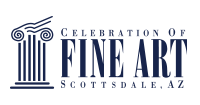What happens when an ancient beadwork technique meets pop art? That is something mixed-media artist and jewelry designer Diana Ferguson recently started exploring and the result was a collection of wall art pieces that manage to balance Warhol-esque funk with elegance and refinement.
Diana’s fascination with beads started in childhood, and it was a passion she continued to casually cultivate into adulthood. But it was the discovery of the ancient peyote stitch technique that suddenly opened up a world of possibilities in her mind––and it was then she knew that this was her path.
For decades now, Diana has been designing and crafting distinctive sculptural jewelry using a combination of peyote stitch and glass Japanese Miyuki Delica beads. Over the years, she’s continued to push the envelope with her designs and continually challenge herself to achieve more complex stitch patterns and shapes. And this year, she expanded beyond wearable art to wall art, creating the grided pop-art series and a collaborative series with artist Kenneth Ferguson called “Bead and Brush”.
Read on or watch the video below to learn more about Diana, her unique process and the new art forms she’s been exploring.
When did you know art was your calling?
I’ve always loved beads since I was little. I experimented with different weaving techniques throughout my early adulthood and came upon peyote stitch, which is the weaving technique that I use most often, and saw that it could be used to create geometric or architectural shapes. That really intrigued me.
What tools do you use to create your unique style?
I work with Miyuki Delica beads for the most part. I prefer them because they’re very precise. They’re manufactured in Japan by a company called Miyuki, and they are large-hole beads with a tremendous range of colors and finishes. They’re just very precise and regular in their shape, so it allows you to create really elegant forms and pieces.
What do you love most about creating art?
I find the bead weaving that I do is incredibly meditative for me. I have a busy brain, so this really suits me. I can focus, and get calm and quiet. I also love the variety of things that I can do with this simple technique to create both the jewelry as well as wall art pieces.
I recently created a bead portrait series in which I use the peyote stitch to create interpretations of iconic images using a very simple and subdued palette of seven colors. They’re really an exploration of how iconic imagery can come into our brains and we can recognize faces and objects just with very simple lines and basic areas of color. And I just think that is quite interesting. I probably have had this idea in my mind for five years. I’ve always, since I was quite young, loved pop art and pop imagery. I’ve kept scrapbooks and collages of people’s faces that I love, and photography I love. This has been an exploration of how I could interpret that passion with the beadwork.
I love working with grid structures, and so you’ll see that concept in these smaller pieces as well. I’m also working with painter Kenneth Ferguson, who does watercolor and gouache paintings, and then I accompany those paintings with my own motifs in the peyote stitch beadwork. Some of the pieces I’ve interpreted Japanese kanji symbols to help tell more of the story of the piece. For instance, on “Intelligence,” which is an American crow, the symbols stand for intelligence, air and flight.
How has your work evolved?
This year I’ve been evolving some of my architectural ideas to create beautiful bracelets like the triangle toggle bracelet and architectural pagoda bracelet. I also have some really fun, reversible triangle pieces which are part of the series called “Equilibrium” that reflects the balance of a triangle.
I think a lot of the creative process is very organic for me, so by working on something leads me to another idea which I’ll then explore. I have a really messy chaotic studio, which means I leave everything out so that I can be inspired. When I see something that is sitting there, it will give me an idea.
What brings you back to the Celebration of Fine Art?
I love the Celebration. It’s been a wonderful growth experience for me personally as an artist. The comradery is incredible. Working with other artists for 72 days is just very inspirational, and I’m always learning new things by being here.
I love the public that comes through. The patrons are very supportive, and it’s great year after year to see your collectors and have them recognize and appreciate how you’re evolving in your work. It’s an incredible experience.
It’s not what you expect before you walk in the door. You may have an impression of what it might be, but once you’re in here––and I hear this over and over again––it is just consuming and people can never see everything in one day, so they come back again and again. I think people appreciate that the opportunity to speak with artists while they’re creating their work is unique.

